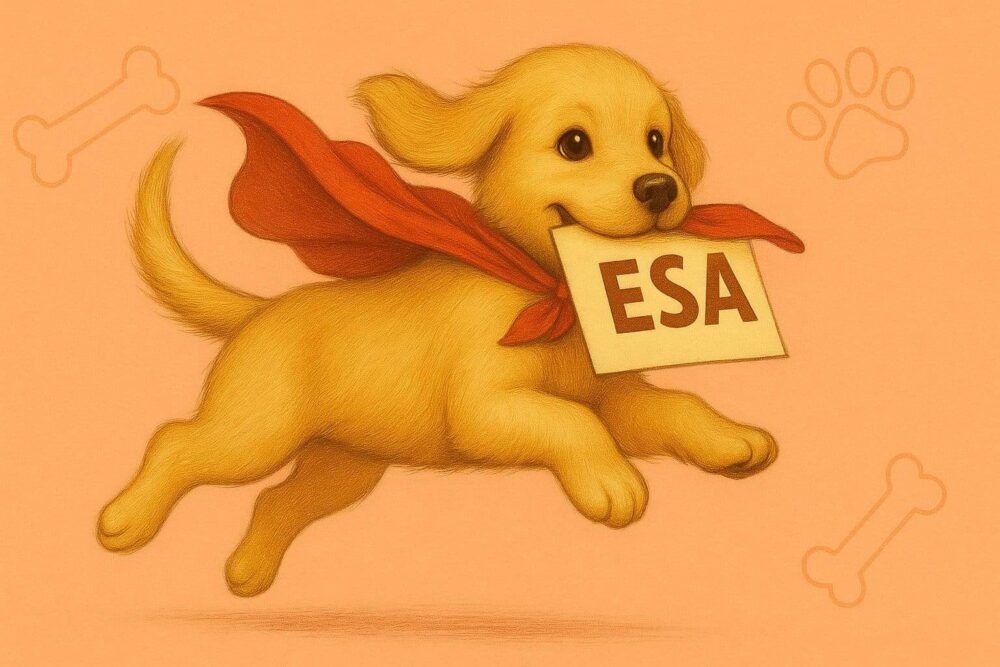Table of Contents
More than one in five U.S. adults live with a mental illness, which means millions are struggling to manage their stress, anxiety, and other day-to-day challenges. While therapy and medication do work, for some, the steady presence of a furry friend can make a huge difference.
We’re talking about emotional support animals (ESAs)—loyal companions who stick by your side like a shadow, offering comfort, easing anxiety, and making the tough days a little softer (and maybe a little furrier).
But what is an ESA exactly, and how is it different from a regular pet? In this article, we’ll explore the role of ESAs in helping you overcome various mental health issues, the process of getting an ESA, and the legal protections that help keep you and your cuddly buddy together.
What Is an ESA?
An ESA is an animal that your licensed mental health professional (LMHP) determines can help you deal with a mental health issue. The LMHP decides if an ESA is right for your condition after a thorough examination.
Generally speaking, if your furry friend is your ESA, their presence provides support and comfort, helping relieve your symptoms and making your journey to recovery easier.
You may qualify for an ESA companion if you’re dealing with mental health conditions that affect your daily life and are outlined by the Diagnostic and Statistical Manual of Mental Disorders (DSM-5-TR)—the definitive reference for LMHPs across the country. Common conditions include:
- Anxiety disorders
- Depression
- Post-traumatic stress disorder (PTSD)
- Panic disorders
- Social anxiety
- Mood disorders
Benefits of an ESA
Spending time with your ESA, feeding them, grooming them, or taking them out for fresh air can encourage healthy routines and a sense of responsibility.
Simply interacting with a pet has been associated with the release of oxytocin (also called the “feel-good” hormone). Imagine what their constant presence can do to improve your mental health!
Other benefits of having an ESA by your side include:
- More physical activity—For those with dogs or other active animals, regular walks and playtime promote physical exercise, which is known to improve mood and overall health
- Social participation—Walking your ESA or visiting pet-friendly spaces often leads to interactions with others, helping reduce feelings of isolation and build social connections
- Emotional regulation—An animal’s presence can serve as a gentle reminder to stay present, breathe, and refocus during stressful or overwhelming moments
- Unconditional support—Unlike people, animals don’t judge. They provide comfort without expectations and boost self-esteem
Are ESAs Service Animals?
While the terms “ESA” and “service animal” are sometimes used interchangeably, they differ significantly in legal rights and responsibilities. In the U.S., ESAs aren’t considered service animals. According to the Americans with Disabilities Act (ADA), service animals are trained to perform specific tasks related to a physical disability, such as:
- Opening and closing doors, cabinets, or drawers for individuals with limited mobility
- Guiding a person with vision impairment safely around obstacles and through crowded areas
- Barking to alert their deaf handler when someone knocks on the door
Meanwhile, an emotional support animal doesn’t have to be trained for specific tasks. They mostly stay with you and offer you companionship, providing a sense of security, easing the feelings of loneliness, and helping create a more stable emotional environment.
In terms of legal protections and provisions, the key difference between the two is highlighted in the table below:
| Emotional Support Animal | Service Animal |
| ESAs are protected under the Fair Housing Act (FHA), which requires landlords to accommodate them even in no-pet housing | Under the ADA, service animals are granted access to most public places regardless of their pet policies, including restaurants, hotels, airports, and stores |
What Animals Can Be an ESA?
Any domesticated pet can be a potential ESA if your LMHP determines that the animal plays a significant role in supporting your mental health. While dogs and cats are the most common choices, other animals may also qualify, including:
- Rabbits
- Guinea pigs
- Birds
- Hamsters
- Miniature horses
Exotic or potentially dangerous animals are generally not recognized as ESAs, but that doesn’t mean ESAs can’t still be unconventional—like in the case of emotional support chickens or an emotional support emu.
How Do LMHPs Determine if an Animal Qualifies as an ESA?
In the process of determining how an ESA supports your condition, LMHPs also assess whether an animal is fit to be an ESA by taking into account their behavior and temperament.
Some animals may struggle in unpredictable or high-stress environments or crowded public spaces. If an animal becomes overwhelmed, aggressive, or distressed, it may fail to provide the intended support and could even heighten the owner’s anxiety. In some cases, LMHPs consult with veterinarians, animal trainers, or behaviorists to assess the animal’s temperament.
Ultimately, regardless of the animal you have, if your LMHP determines you’re suitable for an ESA and your animal is a good fit, you’ll need an official letter confirming this. Instead of getting your animal registered or certified, this letter serves as proof of your pet’s ESA status, allowing you to live with them carefree.
What’s an ESA Letter, and Why Do You Need It?
An ESA letter is an official document from an LMHP confirming that your animal plays a crucial role in your well-being. It can especially be helpful when you’re looking for housing, and restrictions such as strict no-pet policies or costly pet fees are becoming a hurdle.

With a valid ESA letter, you can benefit from legal protections under the FHA, allowing you to live with your ESA even in housing that typically enforces pet restrictions.
How To Get an ESA Letter
Getting an ESA letter for housing purposes involves these steps:
- Finding a licensed mental health professional—Your ESA letter must come from a certified professional, such as a psychiatrist, psychologist, therapist, or clinical social worker, registered and practicing in your state
- Getting evaluated for a diagnosis—Once you find an LMHP, you’ll schedule an appointment so they can assess your condition and determine if you qualify for an ESA. They’ll look for conditions like anxiety, depression, PTSD, or other emotional disorders
- Receiving your ESA letter—If approved, your LMHP will issue an official ESA letter on their letterhead, including their National Provider Identification Number, state license number, certifications, and contact details. You can then present your letter to your landlord or estate agent without revealing your diagnosis
Potential Roadblocks in Getting an ESA Letter
If you’re hoping to get your letter quickly and easily, going the traditional route may be barking up the wrong tree. The process often comes with a few hurdles, including:
- Time-consuming process—Finding a suitable LMHP, scheduling an appointment, undergoing assessment, and waiting for approval can take weeks. Plus, many specialists have packed schedules, and some require multiple sessions before issuing a letter
- Extensive research required—You’ll need to find a professional who’s both licensed in your state and willing to issue ESA letters. Checking credentials, verifying their services, and ensuring they adhere to relevant ESA laws adds another layer of work
- No guaranteed approval—Even after investing time and money, there’s no promise your request will be approved. If the LMHP decides you don’t qualify, you’ll be left without an ESA letter, and you likely won’t get a refund for the consultation
The good news? There’s a way to simplify the process—getting an ESA letter online.
Your Service Animal—A Stress-Free Way To Get Your ESA Letter Online
Getting an ESA letter online is more or less similar to the traditional process, except it happens remotely. It still involves a licensed professional evaluating your condition and issuing your ESA letter if you qualify, but it’s faster and more convenient.
But while the online route is easier, scams are everywhere. For example, some online services may promote free ESA letters—and while you might be able to find a cheap ESA letter, no-cost ones are likely fake. The same goes for self-generated letters—real ones are issued by an LMHP only.
To make sure your ESA letter is legitimate and protects your housing rights, choose a trusted service like Your Service Animal for a smooth and hassle-free experience. Your Service Animal simplifies and fast-tracks the process while meeting various requirements and legal obligations governing the industry. Here’s what you can expect from the service:
| Feature | Benefit |
| A free and quick online quiz | Take a fast online quiz to check your eligibility for an ESA letter before committing to the process |
| A fully online process | From payment to consultation, the entire process happens remotely, so you can get your ESA letter without leaving the comfort of your home |
| Licensed and vetted professionals | Connect with a licensed mental health practitioner in your state for a valid and legally recognized ESA letter |
| Fast turnaround time | If approved, you’ll receive it via email within 24–48 hours of your online consultation |
| A 100% money-back guarantee | If you aren’t approved or your landlord rejects your letter, you’ll get a full refund—no risk, no hassle |
Get an ESA Letter ASAP
If you’re ready to take your animal companion to your new home, follow these easy steps to get your ESA letter via Your Service Animal:
- Find out if you’re a good fit for an ESA letter with our online quiz
- Schedule an online appointment with a licensed mental health practitioner in your state
- Attend the online call and receive your ESA letter if clinically appropriate
- Receive a full refund if the therapist doesn’t issue an ESA letter or your landlord rejects your letter
And just like that, you’ll be cozy with your animal friend in your dream home in no time.









